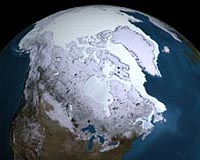| . |  |
. |
Pasadena CA (SPX) Jul 09, 2009 Scientists have evaluated for the first time how much the thickness and volume of Arctic sea ice, not just the ice's surface area, have shrunk since 2004 across the Arctic Ocean basin. Even where the sea ice cover persists despite climate change in the region, a vast portion of the remaining ice layer has become thinner than it used to be, the new study finds. "Even in years when the overall extent of sea ice remains stable or grows slightly, the thickness and volume of the ice cover is continuing to decline, making the ice more vulnerable to continued shrinkage," says Ron Kwok, senior research scientist at NASA's Jet Propulsion laboratory in Pasadena, Calif., and leader of the study. Kwok and colleagues at NASA and the University of Washington, in Seattle, report that Arctic sea ice thinned dramatically between the winters of 2004 and 2008, with thin seasonal ice replacing thick, older ice as the dominant type for the first time on record. Using ICESat measurements, scientists found that overall Arctic sea ice thinned about 17.8 centimeters (7 inches) a year, for a total of 67 cm (2.2 feet) over four winters. The total area covered by the thicker, older, multi-year ice that survives one or more summers shrank by more than 40 percent. The team's findings were published in the Journal of Geophysical Research- Oceans, a publication of the American Geophysical Union (AGU). The researchers used measurements from NASA's Ice, Cloud and land Elevation Satellite (ICESat) to generate the first basin-wide estimate of the thickness and volume of the Arctic Ocean's ice cover. The data covers the period from the fall of 2003 through the winter of 2008. Kwok says the results offer a better understanding of the regional distribution of thick and thin ice in the Arctic, presenting a much more telling picture of what's going on in the Arctic than measurements of how much of the Arctic Ocean is covered in ice alone can. "Ice volume allows us to calculate annual ice production and gives us an inventory of the freshwater and total ice mass stored in Arctic sea ice," he notes. "Our data will help scientists better understand how fast the volume of Arctic ice is decreasing and how soon we might see a nearly ice-free Arctic in the summer." The Arctic ice cap grows each winter as the sun sets for several months and intense cold sets in. In the summer, driven by wind and ocean currents, some of that ice naturally flows out of the Arctic, while much of it melts in place. But not all of the Arctic ice thaws each summer: the thicker, older ice is more likely to survive. Seasonal sea ice usually reaches about 1.83 meters (6 feet) in thickness, while multi-year ice averages 2.74 m (9 ft). In recent years, however, the amount of ice replaced in the winter has not been sufficient to replace summer ice losses. This leads to more open water in summer, which then absorbs more heat, warming the ocean and further melting the ice. Between 2004 and 2008, multi-year ice cover shrank 42 percent, or 1.54 million square kilometers (595,000 square miles) - nearly the size of Alaska's land area. During the study period, the relative contributions of the two ice types to the total volume of the Arctic's ice cover did a complete flip-flop. In 2003, 62 percent of the Arctic's total ice volume was stored in multi-year ice, with 38 percent stored in first-year seasonal ice. By 2008, 68 percent of the total ice volume was first-year ice, with 32 percent multi-year. Study co-author and ICESat Project Scientist Jay Zwally of NASA's Goddard Space Flight Center, Greenbelt, Md., says ICESat makes it possible to monitor ice thickness and volume changes over the entire Arctic Ocean for the first time. "One of the main things that has been missing from information about what is happening with sea ice is comprehensive data about ice thickness," says Zwally. "U.S. Navy submarines provide a long-term, high-resolution record of ice thickness over only parts of the Arctic. The submarine data agree with the ICESat measurements, giving us great confidence in satellites as a way of monitoring thickness across the whole Arctic Basin." The authors attribute the changes in the overall thickness and volume of Arctic Ocean sea ice to the recent warming and anomalies in patterns of sea ice circulation. "The near-zero replenishment of the multi-year ice cover, combined with unusual exports of ice out of the Arctic after the summers of 2005 and 2007, have both played significant roles in the loss of Arctic sea ice volume over the ICESat record," says Kwok. Share This Article With Planet Earth
Related Links University of Washington Beyond the Ice Age
 The Least Sea Ice In 800 Years
The Least Sea Ice In 800 YearsCopenhagen, Denmark (SPX) Jul 03, 2009 New research, which reconstructs the extent of ice in the sea between Greenland and Svalbard from the 13th century to the present indicates that there has never been so little sea ice as there is now. The research results from the Niels Bohr Institute, among others, are published in the scientific journal, Climate Dynamics. There are of course neither satellite images nor instrumental ... read more |
|
| The content herein, unless otherwise known to be public domain, are Copyright 1995-2009 - SpaceDaily. AFP and UPI Wire Stories are copyright Agence France-Presse and United Press International. ESA Portal Reports are copyright European Space Agency. All NASA sourced material is public domain. Additional copyrights may apply in whole or part to other bona fide parties. Advertising does not imply endorsement,agreement or approval of any opinions, statements or information provided by SpaceDaily on any Web page published or hosted by SpaceDaily. Privacy Statement |